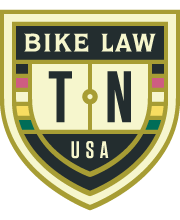After handling hundreds of cases, we have learned that a bike crash is rarely a “bike accident.” As a Tennessee bike crash attorney, Amy knows the difference. Amy has represented cyclists in Chattanooga, Knoxville, Memphis, Nashville, and from all across the state.
This article serves as an overview of some of the laws which apply to cyclists while riding in Tennessee. Bicycles are defined as vehicles and are lawfully allowed on many roadways in Tennessee, subject to certain provisions which are designed with cyclist safety in mind.
Fault
Determining fault is a requirement in any lawsuit, and an award of damages to a cyclist in a collision case hinges on whether or not a plaintiff can prove this key element. Tennessee law requires a plaintiff to prove that a defendant was negligent (had a duty to exercise reasonable care (or more) in a given situation, breached that duty, causing damages to the plaintiff as a natural foreseeable result of the breach of duty), and that the combined negligence of all persons responsible for the plaintiff’s injuries, other than the plaintiff themselves, amounts to 51% or greater. In a Tennessee Supreme Court opinion issued in 1992, Tennessee adopted a modified comparative fault to be used in assessing damages in personal injury cases. Defendants can raise the issue of contributory negligence of a plaintiff, but so long as a plaintiff remains less at fault than the defendant, and the plaintiff’s fault is less than half the total fault, a plaintiff will recover. So long as a plaintiff is determined to be 49% at fault or less, they can recover for their damages, with the amount of recovery reduced proportionately by the amount which they are determined to be at fault. It is important to remember that the persons whose job it is to determine fault in a bicycle collision case, are the jury; not the judge, not the attorneys, and not the insurance adjustors. A jury has the job of determining the fault, if any, of each person against whom fault is asserted. The fault of multiple defendants, including those unnamed or immune from suit, may be combined to reach the 51% threshold.



